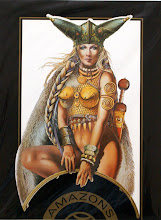Robert Nixon was a regular contributor to The Beano for many years, best known for his work on the likes of "Roger the Dodger" and "Lord Snooty". Nixon's clean line and storytelling talents meant that word balloons were scarcely necessary for readers to follow the action. Nixon had a talent for ghosting styles, whether they were Ken Reid, Leo Baxendale or Dudley D. Watkins, but brought to his artwork a distinctive cuteness. Nixon's editor at The Beano told The Guardian that Nixon would have been able to illustrate a note to the milkman and still make it look appealing.
Robert Thomas Nixon was born in South Bank, near Middlesbrough in North Yorkshire, on 7 July 1939, the fifth of six children born to Arthur W. Nixon, a steelworker, and his wife Phyllis (nee Thompson), who had married in 1931. He was educated at Cromwell Road School and the Central Secondary Modern School, both in South Bank, where his youthful artistic talents were encouraged. He won several art competitions and earned himself a scholarship to Middlesbrough Art College in September 1954 but he became disillusioned with the course and dropped out. Instead, he found work as an apprentice lithographer and photo-retoucher at a printing factory. That same year, 1955, his father died at the early of 49.
Nixon married Rita M. Kelly in Middlesbrough in 1961 and had four children: Paul H. (1962), Anthony R. (1964), Wendy Anita (1966) and Catherine Ann (1968).
A fellow student encouraged him to try cartooning and he began trying his hand at cartooning, submitting samples to D. C. Thomson. His first success was to produce three fill-in episodes for The Beano's "Little Plum", the first published in April 1964. Later that year, Ken Reid departed from The Beano and Nixon took over his "Roger the Dodger", which he continued to draw until 1973. He turned freelance and 1965, soon after which the family moved to Guisborough, Cleveland.
In 1968, Nixon inherited "Lord Snooty" from Dudley D. Watkins. Later strips for Thomsons included "Esky Mo" (1969) and "Captain Cutler" (1972) for Sparky and "Grandpa" for The Beano (1971).
Nixon was offered work – and the higher page rate of £17 as opposed to £12 a page – by IPC Publications, who were expanding their range of humour titles following the success of Whizzer & Chips and he began contributing "Hire a Horror" and "Ivor Lott and Tony Broke" to Cor!! in 1972 and "Soggy the Sea Monster" and "Frankie Stein" in Shiver & Shake in 1973. This work enabled him to work full-time for IPC, who soon added Whoopee!, Monster Fun and Krazy to their line-up of titles, to which Nixon contributed "King Arthur and His Frights of the Round Table" (1974), "Kid Kong" (1974) "12½p Buytonic Boy" (1976).
Nixon drew "The Gems", written by Trevor Metcalfe, for The Sun newspaper for eighteen months in 1976-78, but his main output continued to be weekly strips for IPC. He took over "Gums" for Buster and "Kid King" for Jackpot as well as creating "Laser Eraser" for the latter (1979); "Elephant on the Run" (1978) and "Stage School" (1979) ran in Cheeky Weekly and "Ossie" (1982) and "Family Trees" (1983) in Wow!. During this period, he also drew "Parkie" (1982) for a local newspaper, the Middlesbrough Evening Gazette. At his peak he was producing nine pages a week.
After fifteen-years, the newly appointed editor of The Beano, Euan Kerr, tried to tempt him back but without success. Later that same week, the editor of IPC's humour titles called with the news that mergers would leave him with fewer pages to work on; Nixon contacted Kerr and asked if the offer of work was still open.
Nixon was tempted back to D. C. Thomson, where his first "Roger the Dodger" strip appeared in January 1985. Nixon's favourite amongst the characters he created debuted in The Beano later that same year: "Ivy the Terrible",followed by "Willie Fixit" (1985) in Topper and "Polar Blair" (1985) for the newly launched Hoot.
Nixon took over the artwork for both "Korky the Cat" (The Dandy) and "Beryl the Peril" (Topper) in 1986, and continued to draw various other strips for The Beano, including "Little Monkey" (1987) and "Roger's Dodge Clinic" (1989). Nixon also illustrated related merchandise, including jigsaws and Easter egg boxes.
As an artist, Nixon had already illustrated cartoon greetings cards for the Noel Tatt Company and joke books written by Gyles Brandreth. In his spare time, he enjoyed painting fantasy landscapes in oils, pastels and watercolours.
Nixon continued to draw until his death on 22 October 2002, aged 63, his final page – the cover for the Beano Summer Special (2003) – arriving the day before he died. His longest-running strip, "Roger the Dodger" was continued by Barrie Appleby for some years and a series of Nixon reprints were introduced in 2011 before Appleby returned the following year.
Books Illustrated
More Crazy Jokes by Janet Rogers. London, Beaver, 1980.
Amazing Facts About the Living World by Derek Hall, illus. with Stephen Lings. London, Beaver Books, 1983.
Crazy Practical Jokes by Janet Rogers. London, Beaver, 1983.
The Crazy Joker's Handbook by Janet Rogers. London, Beaver, 1984.
The Rudest Joke Book in the World by Gyles Brandreth, Sevenoaks, Knight, 1985.
The Joke-a-Day Fun Book by Janet Rogers. London, Beaver, 1986.
Crazy Jokes by Gyles Brandreth, illus. with Graham Thompson & John Smyth. London, Madcap, 1997.
Crazy Practical Jokes by Gyles Brandreth. London, Madcap, 1997.
Bumper Book of Laughs by Gyles Brandreth, illus. with Colin Hawkins, Sara Silcock. London, Madcap, 1999.
Examples of Robert Nixon's artwork can be found at the Illustration Art Gallery.
Subscribe to:
Post Comments (Atom)





















The Gems was replaced by Hagar The Horrible. I was 9 when it appeared in my dad's paper and seeing Nixon's distinct artwork outside a comic was completely surreal. Metcalfe came up with the idea and wrote it. He also worded the speech bubbles.
ReplyDelete